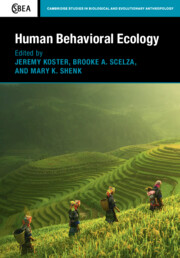Book contents
- Human Behavioral Ecology
- Cambridge Studies in Biological and Evolutionary Anthropology
- Human Behavioral Ecology
- Copyright page
- Contents
- Contributors
- Foreword: Reflections on Five Decades of Human Behavioral Ecology
- 1 Human Behavioral Ecology
- 2 Life History
- 3 Foraging Strategies
- 4 Modes of Production
- 5 Cooperation
- 6 Division of Labor
- 7 Status
- 8 Political Organization
- 9 Mating
- 10 Marriage
- 11 Parental Care
- 12 Allocare
- 13 Demography
- 14 Human Biology
- 15 Cultural Evolution
- 16 Evolutionary Psychology
- 17 The End of Human Behavioral Ecology
- Bibliography
- Index
6 - Division of Labor
Published online by Cambridge University Press: 07 March 2024
- Human Behavioral Ecology
- Cambridge Studies in Biological and Evolutionary Anthropology
- Human Behavioral Ecology
- Copyright page
- Contents
- Contributors
- Foreword: Reflections on Five Decades of Human Behavioral Ecology
- 1 Human Behavioral Ecology
- 2 Life History
- 3 Foraging Strategies
- 4 Modes of Production
- 5 Cooperation
- 6 Division of Labor
- 7 Status
- 8 Political Organization
- 9 Mating
- 10 Marriage
- 11 Parental Care
- 12 Allocare
- 13 Demography
- 14 Human Biology
- 15 Cultural Evolution
- 16 Evolutionary Psychology
- 17 The End of Human Behavioral Ecology
- Bibliography
- Index
Summary
Divisions of labor are common among many species. They occur when some sets of individuals (usually defined by age or gender) regularly perform specific tasks, either as a result of individual decision-making patterned by social and ecological contexts (differences in labor), or emerging from an organized, cooperative task specialization designed to benefit a larger collective (divisions of labor). This chapter explores both differences in labor and divisions of labor by drawing on ethnographic cases of subsistence production. These case studies illustrate how intrinsic variation in size and strength may structure differences in labor by age, and they demonstrate how variation in the assessment of acquisition risk may influence women’s and men’s subsistence decisions. These differences may lead to true cooperative divisions of labor when team rates, bargaining, or signaling reduce conflicts of interest between individuals, in turn facilitating increased returns to scale for larger collectives, families, households, or other unit of economic production. Understanding the maintenance of patterns in "divisions of" and "differences in" labor provides a firmer foundation for explanatory models of human decision-making, ranging from questions about the emergence of our genus to contemporary patterning in occupational specialization and gender identity.
Keywords
- Type
- Chapter
- Information
- Human Behavioral Ecology , pp. 130 - 152Publisher: Cambridge University PressPrint publication year: 2024

